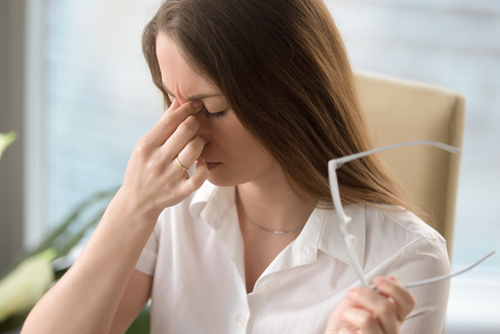How Do I Know If I Have Dry Eyes?
Dry eye can cause discomfort, irritation, and even vision problems, making it essential to understand the condition’s symptoms, causes, and treatment options. At Mid Ohio Eye, we understand the importance of healthy and comfortable eyes.
Keep reading to learn more about dry eye, including how to know if you may be experiencing this eye condition!
What is Dry Eye Syndrome?
Dry eye is a common eye condition in which your eyes are unable to produce enough tears or the tears evaporate too quickly. Tears are important to keep your eyes healthy and lubricated, and when they are not produced in sufficient amounts or are of poor quality, it can lead to discomfort and even damage to the surface of the eye.
Dry eye syndrome can occur at any age, and it is a common problem for people of all genders. However, certain factors may increase the risk of developing dry eyes.
For example, your chance of developing dry eye increases as you age. Women are also more likely to develop dry eyes due to hormonal changes that occur during pregnancy, menopause, or when taking birth control pills.
Those who have certain medical conditions, like diabetes, rheumatoid arthritis, or thyroid disease, may also be at higher risk of developing dry eye. Additionally, environmental factors such as air conditioning, wind, or dry climates can exacerbate your symptoms.
What Are the Symptoms of Dry Eye?
There are many possible symptoms of dry eye syndrome. However, some of the most common are:
- Irritation
- Redness
- Blurry vision
- Discomfort
- Increased tearing
- Sensitivity to light
- Feeling like you have something in your eye
Any of these symptoms may indicate dry eye syndrome. However, they can also be a sign of other eye conditions.
The best way to know what is causing your symptoms is to visit your eye doctor at Mid Ohio Eye for a thorough evaluation. At this evaluation, your eye doctor will be able to determine the root cause of your symptoms and develop a treatment plan to help improve them.
Can Dry Eye Syndrome Be Prevented?
While it may not be possible to prevent all cases of dry eye, there are some steps you can take to reduce the risk of developing this condition or to manage its symptoms. For example, try to blink regularly when using digital devices.
When you look at screens, your eyes naturally blink less, leading to dryness on the surface of your eyes. Remembering to blink more often can help prevent eye strain and your eyes from losing too much lubrication.
Additionally, using a humidifier to add moisture to the air can help prevent dry eyes. Wearing protective eyewear when exposed to irritants, staying hydrated, eating a healthy diet, and avoiding smoking are other measures that can help reduce the risk or manage symptoms of dry eye.
Although none of these measures can guarantee the prevention of dry eye, they can help reduce its risk and manage the symptoms.
When Should I See an Eye Doctor For Dry Eyes?
If you experience persistent or severe dry eye symptoms, you should see an eye doctor for an evaluation. Symptoms such as pain, blurred vision, or a sensation of something being in your eye may indicate a more severe underlying condition.
Additionally, if you have been using over-the-counter treatments for more than a week without relief, it’s time to see your eye doctor. Dry eyes can lead to more severe complications if left untreated, such as corneal damage or infection, so early diagnosis and treatment are essential.
Your eye doctor may perform an eye exam, measure your tear production, or conduct other tests to diagnose dry eye and recommend the appropriate treatment.
Are you experiencing symptoms of dry eye? Schedule an appointment at Mid Ohio Eye in Columbus, OH, today!










